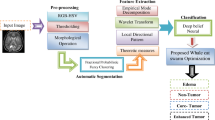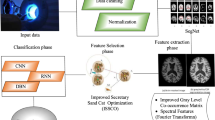Abstract
Medical image processing is a challenging and complex field. Moreover, the brain tumor is one of the significant factors for death in human beings. Therefore, detection of brain tumor at the initial stage is very essential. In this paper, a hybrid deep belief neural network with adaptive search and rescue algorithm (DBN-ASAR) is proposed to classify the tumor images and the normal images from the MRI brain images. Pre-processing is the initial process, in which the Fuzzy based Fast averaging peer group (FFAPG) filtering approach is proposed to eliminate the impulsive noises from the MRI brain images. In features extraction, discrete wavelet transform with Gabor filter (DWT-GF) is used to extract the texture and shape features from the images effectively. From these extracted features, only the optimal features are selected to decrease the dimensionality. Hybrid feature selection approach is proposed to obtain the optimal features and dimensionality reduction. Next phase is the classification, in which the selected features are trained using deep belief network (DBN). Adaptive search and rescue (ASAR) algorithm is combined with DBN model to obtain the optimal classification solution; thus the normal and tumor images are classified. From the classified images, only the tumor images are fed as input for the segmentation process. Using threshold with tree growth algorithm (TTGA), the tumor region is detected effectively from the tumor images. MATLAB tool is used for the experimentation of proposed model. Figshare, BRATS 2013, 2015 and 2018 datasets are utilized for the evaluation of proposed work. Accuracy, precision, sensitivity, F-measure, specificity, DSC, NPV and FPR are the performance metrics considered to evaluate the efficiency of the proposed approach. The simulation results proved that the performance of the proposed method is better than the state-of-the-art methods.













Similar content being viewed by others
References
Abdel-Zaher AM, Eldeib AM (2016) Breast cancer classification using deep belief networks. Expert Syst Appl 46:139–144
Amin J, Sharif M, Anjum MA, Raza M, Bukhari SAC (2020) Convolutional neural network with batch normalization for glioma and stroke lesion detection using MRI. Cogn Syst Res 59:304–311
Amin J, Sharif M, Gul N, Yasmin M, Shad SA (2020) Brain tumor classification based on DWT fusion of MRI sequences using convolutional neural network. Pattern Recogn Lett 129:115–122
Arnal J, Chillarón M, Parcero E, Súcar LB, Vidal V (2020) A parallel fuzzy algorithm for real-time medical image enhancement. Int J Fuzzy Syst 22(8):2599–2612
Arunkumar N, Mohammed MA, Mostafa SA, Ibrahim DA, Rodrigues JJ, de Albuquerque VHC (2020) Fully automatic model-based segmentation and classification approach for MRI brain tumor using artificial neural networks. Concurrency and Computation: Practice and Experience 32(1):e4962
Casini L, Roccetti M (2020) Medical imaging and artificial intelligence. In: Lalumera E, Fanti S (eds) Philosophy of advanced medical imaging. SpringerBriefs in ethics. Springer, Cham
Chandra SK, Bajpai MK (2020) Brain tumor detection and segmentation using mesh-free super-diffusive model. Multimed Tools Appl 79(3):2653–2670
Chaudhary A, Bhattacharjee V (2020) An efficient method for brain tumor detection and categorization using MRI images by K-means clustering & DWT. Int J Inf Technol 12(1):141–148
Chen S, Ding C, Liu M (2019) Dual-force convolutional neural networks for accurate brain tumor segmentation. Pattern Recogn 88:90–100
Cheraghalipour A, Hajiaghaei-Keshteli M, Paydar MM (2018) Tree growth algorithm (TGA): a novel approach for solving optimization problems. Eng Appl Artif Intell 72:393–414
Deb D, Roy S (2021) Brain tumor detection based on hybrid deep neural network in MRI by adaptive squirrel search optimization. Multimed Tools Appl 80(2):2621–2645
Dong H, Yang G, Liu F, Mo Y, Guo Y (2017) Automatic brain tumor detection and segmentation using u-net based fully convolutional networks. In: Annual conference on medical image understanding and analysis. Springer, Cham, pp 506–517
Han C, Rundo L, Araki R, Furukawa Y, Mauri G, Nakayama H, Hayashi H (2020) Infinite brain MR images: PGGAN-based data augmentation for tumor detection. In: Neural approaches to dynamics of signal exchanges. Springer, Singapore, pp 291–303
Harifi S, Khalilian M, Mohammadzadeh J, Ebrahimnejad S (2019) Emperor penguins Colony: a new metaheuristic algorithm for optimization. Evol Intel 12(2):211–226
Ismael SAA, Mohammed A, Hefny H (2020) An enhanced deep learning approach for brain cancer MRI images classification using residual networks. Artif Intell Med 102:101779
Kalaiselvi T, Padmapriya ST, Sriramakrishnan P, Somasundaram K (2020) Deriving tumor detection models using convolutional neural networks from MRI of human brain scans. Int J Inf Technol:1–6
Kalpana R, Chandrasekar P (2020) An optimized technique for brain tumor classification and detection with radiation dosage calculation in MR image. Microprocess Microsyst 72:102903
Kaplan K, Kaya Y, Kuncan M, Ertunç HM (2020) Brain tumor classification using modified local Binary Patterns (LBP) feature extraction methods. Med Hypotheses 139:109696
Kaur G, Oberoi A (2020) Novel approach for brain tumor detection based on Naïve Bayes classification. In: Data management, analytics and innovation. Springer, Singapore, pp 451–462
Khan H, Shah PM, Shah MA, Islam S, Rodrigues JJ (2020) Cascading handcrafted features and convolutional neural network for IoT-enabled brain tumor segmentation. Comput Commun 153:196–207
Kumar GA, Sridevi PV (2021) E-fuzzy feature fusion and thresholding for morphology segmentation of brain MRI modalities. Multimed Tools Appl 80:1–21
Kumar DM, Satyanarayana D, Prasad MG (2021) MRI brain tumor detection using optimal possibilistic fuzzy C-means clustering algorithm and adaptive k-nearest neighbor classifier. J Ambient Intell Humaniz Comput 12(2):2867–2880
Lahmiri S, Boukadoum M (2013) Hybrid discrete wavelet transform and Gabor filter banks processing for features extraction from biomedical images. J Med Eng
McKinney SM et al (2020) International evaluation of an AI system for breast cancer screening. Nature 577:89–94
Menze BH, Jakab A, Bauer S, Kalpathy-Cramer J, Farahani K, Kirby J, Burren Y, Porz N, Slotboom J, Wiest R, Lanczi L (2014) The multimodal brain tumor image segmentation benchmark (BRATS). IEEE Trans Med Imaging 34(10):1993–2024
Özyurt F, Sert E, Avcı D (2020) An expert system for brain tumor detection: fuzzy C-means with super resolution and convolutional neural network with extreme learning machine. Med Hypotheses 134:109433
Pereira S, Pinto A, Alves V, Silva CA (2019) Brain tumor segmentation using convolutional neural networks in MRI images. IEEE Trans Med Imaging 35(5):1240–1251
Preethi S, Aishwarya P (2021) An efficient wavelet-based image fusion for brain tumor detection and segmentation over PET and MRI image. Multimed Tools Appl:1–18
Rehman A, Naz S, Razzak MI, Akram F, Imran M (2020) A deep learning-based framework for automatic brain tumors classification using transfer learning. Circuits Syst Signal Process 39(2):757–775
Rehman A, Naz S, Razzak MI, Akram F, Imran M (2020) A deep learning-based framework for automatic brain tumors classification using transfer learning. Circuits Syst Signal Process 39(2):757–775
Saba T, Mohamed AS, El-Affendi M, Sharif MAJ (2020) Brain tumor detection using fusion of hand crafted and deep learning features. Cogn Syst Res 59:221–230
Shabani A, Asgarian B, Gharebaghi SA, Salido MA, Giret A (2019) A new optimization algorithm based on search and rescue operations. Math Probl Eng 2019:1–23
Sharif M, Amin J, Nisar MW, Anjum MA, Muhammad N, Shad SA (2020) A unified patch based method for brain tumor detection using features fusion. Cogn Syst Res 59:273–286
Sharif M, Amin J, Raza M, Yasmin M, Satapathy SC (2020) An integrated design of particle swarm optimization (PSO) with fusion of features for detection of brain tumor. Pattern Recogn Lett 129:150–157
Sharif M, Amin J, Raza M, Anjum MA, Afzal H, Shad SA (2020) Brain tumor detection based on extreme learning. Neural Comput Appl:1–13
Sharma M, Miglani N (2020) Automated brain tumor segmentation in MRI images using deep learning: overview, challenges and future. In: Deep learning techniques for biomedical and health informatics. Springer, Cham, pp 347–383
Shen L, He M, Shen N, Yousefi N, Wang C, Liu G (2020) Optimal breast tumor diagnosis using discrete wavelet transform and deep belief network based on improved sunflower optimization method. Biomed Signal Process Control 60:101953
Taheri S, Ong SH, Chong VFH (2010) Level-set segmentation of brain tumors using a threshold-based speed function. Image Vis Comput 28(1):26–37
Toğaçar M, Ergen B, Cömert Z (2020) BrainMRNet: brain tumor detection using magnetic resonance images with a novel convolutional neural network model. Med Hypotheses 134:109531
Vijh S, Sharma S, Gaurav P (2020) Brain tumor segmentation using OTSU embedded adaptive particle swarm optimization method and convolutional neural network. In: Data visualization and knowledge engineering. Springer, Cham, pp 171–194
Wang G, Li W, Ourselin S, Vercauteren T (2017) Automatic brain tumor segmentation using cascaded anisotropic convolutional neural networks. In: International MICCAI brainlesion workshop. Springer, Cham, pp 178–190
Yin B, Wang C, Abza F (2020) New brain tumor classification method based on an improved version of whale optimization algorithm. Biomed Signal Process Control 56:101728
Yin B, Wang C, Abza F (2020) New brain tumor classification method based on an improved version of whale optimization algorithm. Biomed Signal Process Control 56:101728
Zhang J, Zeng J, Qin P, Zhao L (2021) Brain tumor segmentation of multi-modality MR images via triple intersecting U-nets. Neurocomputing 421:195–209
Author information
Authors and Affiliations
Corresponding author
Additional information
Publisher’s note
Springer Nature remains neutral with regard to jurisdictional claims in published maps and institutional affiliations.
Rights and permissions
About this article
Cite this article
Santhosh Kumar H S, Karibasappa, K. An effective hybrid deep learning with adaptive search and rescue for brain tumor detection. Multimed Tools Appl 81, 17669–17701 (2022). https://doi.org/10.1007/s11042-022-12474-2
Received:
Revised:
Accepted:
Published:
Issue Date:
DOI: https://doi.org/10.1007/s11042-022-12474-2




